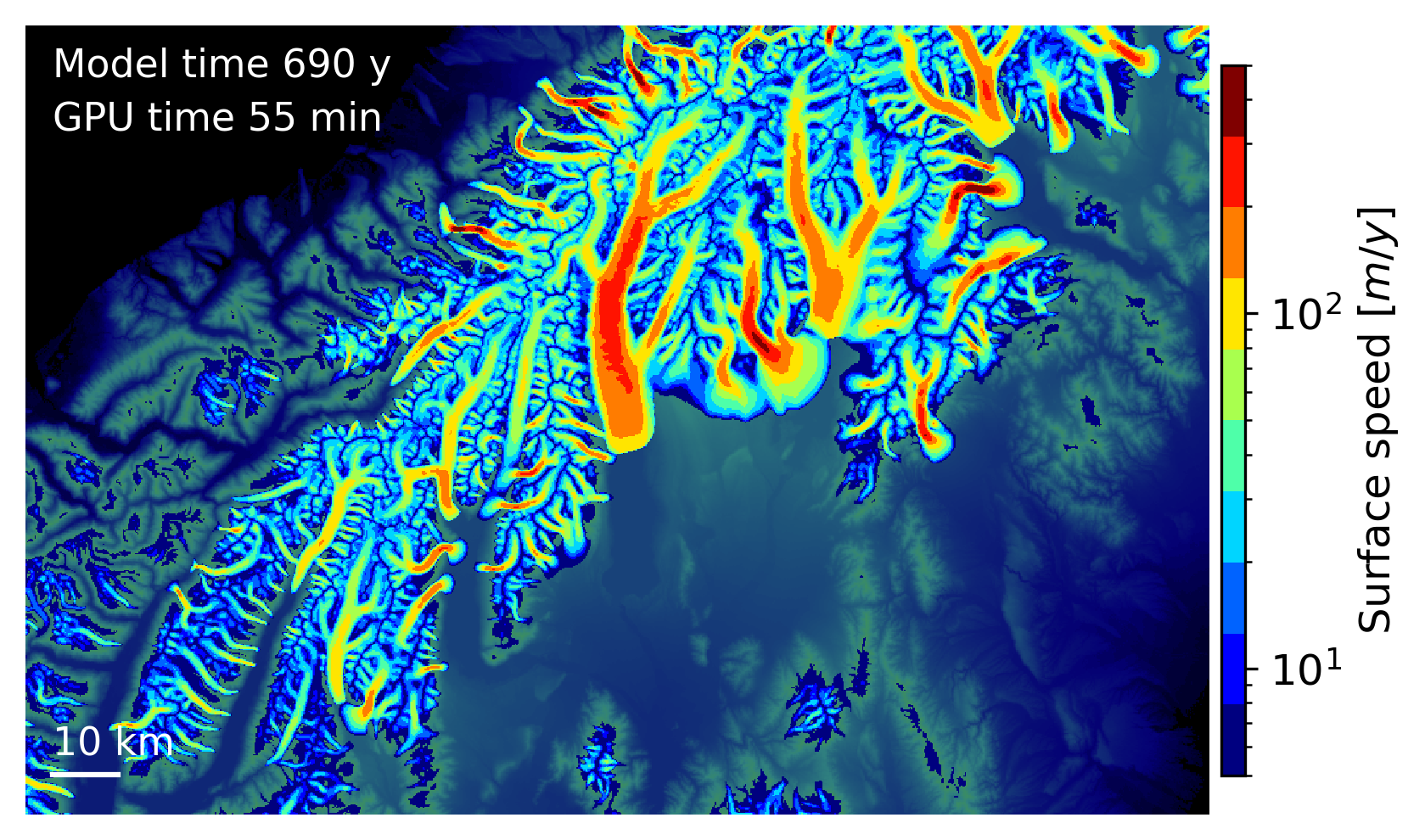In ICE, we develop/run glacier ice flow models and use machine learning techniques to better understand paleo climates, the resulting glaciations and the traces they have left on the landscape in the Alps, as well the ongoing and future evolution of glaciers under climate change.
A special emphasis is given to the development of the “Instructed Glacier Model, IGM”, which can simulate the coupling between surface mass balance, mass conservation, ice dynamics, and glacial erosion to predict the evolution of glaciers and the underlying landscape. The specificity of IGM is that it models the ice flow using a deep-learning emulator, which is trained with state-of-the-art ice flow models. By doing so, IGM permits the speed-up of several orders of magnitude at the cost of a minor loss in accuracy. IGM is an open-source Python code, which runs across both CPU and GPU and permits user-friendly, highly efficient, mechanically state-of-the-art glacier simulations.

The computational capabilities of IGM open new perspectives of applications in paleo glacier modeling that are not achievable with traditional modeling. We exploit these capabilities to perform glacier simulations e.g., i) over long-time scales to explore the Quaternary period ii) in high-resolution to resolve the complex high mountain topography of the Alps iii) a large number of times to investigate the impact of key climatic parameters.
Check this page if you are looking for Bachelor’s or Master’s project.
The current research projects of ICE in glacier modeling are:
Paleo climate inversion (PhD Kejdi Lleshi, supervision G. Jouvet / F. Herman): In this project, we investigate using IGM and machine learning techniques what climate conditions may have applied in the Alps to allow glaciers to build and reach the positions indicated by moraines.
Landscape evolution modelling (PhD Brandon Finley, supervision G. Jouvet / F. Herman): The goal of this project is to include new components in IGM to simulate the landscape evolution in the Alps during the quaternary period.
Glacier bedrock inference (PostDoc Samuel Cook, fellowship FGSE): In this project, we use the IGM inversion capabilities to reconstruct the basal conditions of glaciers around the world.
RECONCILE (PostDoc Sarah Kamleitner, PostDoc Tancrède Leger, SNSF project, PIs: G. Jouvet, A. Vieli, S. Nussbaumer): In this project entitled “Reconciling geological and modeled reconstructions of Alpine glacier evolution from the Last Glacial Maximum into the Holocene”, we will develop and use IGM to model in high-resolution the evolution of the Alpine Ice Field (AIF) during the last glacial cycle in order to resolve discrepancies between existing geological and modeled reconstructions.
The Ice Age Machine (Brandon Finley, funded by the SNSF, in collaboration with the University of Zurich and Zurich University of the Arts): In this science communication AGORA project, we design the AI-based visualization part of the «The Ice Age Machine», which is a user-friendly and interactive module that permits to visualize the history of glaciations in the Alps, as well as the effect of climate change on the landscape.
COEBELI (SNSF project, PI: Martin Lüthi UZH): The project aims to better understand environmental, basal, englacial and lateral influences on channelized outlet glaciers such that the Jakobshavn Isbrae, Greenland, from field observations and numerical modelling. In this project, we have participated (G: Jouvet) to collect data using long-range drone during the 2022 fieldwork at Jakobshavn Isbrae. Hugo Rousseau (postdoc at the University of Zurich, currently host in the ICE group), is working on modelling ice fracturing using particle methods in collaboration with Johan Gaume (SLF Davos/ETHZ).
